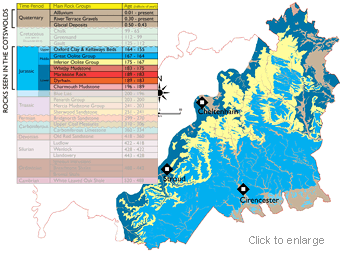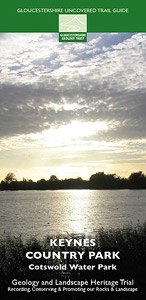Cotswolds Geology
 The Cotswold Hills stretch for nearly 60 miles, part of an outcrop of Jurassic rocks that runs NE from the Dorset coast to the North Sea off Yorkshire. The rocks that form the Cotswold Hills are made up of three different geological stages of the Jurassic period and date from between 210-140 million years ago. The Cotswold Hills stretch for nearly 60 miles, part of an outcrop of Jurassic rocks that runs NE from the Dorset coast to the North Sea off Yorkshire. The rocks that form the Cotswold Hills are made up of three different geological stages of the Jurassic period and date from between 210-140 million years ago.
The steep western scarp of the Cotswolds exposes sections through Lower and Middle Jurassic rocks that dip gently eastwards towards Oxford and London. At Leckhampton Hill and Cleeve Common, the thickest and most complete sections of Inferior Oolite rocks anywhere in the country are exposed, recognised by their designation as Sites of Special Scientific Interest. Further to the south-east exposures of the Great Oolite can be found in numerous quarries and cuttings.
The Lower Jurassic rocks are made up of the Lias Group and the Middle Jurassic rocks consist of the Inferior Oolite Group and Great Oolite Group. Each of these groups is separated into various smaller divisions called Formations, and in the Middle Jurassic rocks, these formations are often sub-divided into Members. The different groups, formations and members are distinguished from each other according to differences in the types of rock, the types of fossils found in the rocks, and by erosion surfaces that mark breaks in deposition of the sediments.
The rocks that from the Cotswold Escarpment are almost exclusively marine, and were formed mainly in warm tropical seas, much like those around Bermuda today. Plate tectonics has transported this part of the Earth's crust northward over the last 150-200 million years until we reached our present position.
There are two main types of sediment found in the rocks of the Cotswolds; the clastics and the carbonates. Clastics consist of particles of material eroded from rocks on land and transported by rivers wind and form the clays, muds and sands and can have a very wide distribution over the sea floor. The carbonates are generally produced by precipitation of calcium carbonate and by accumulation chemicals from dead organisms, what we know as fossils, and form the limestones. These have a much narrower zone in which they form being restricted to shallow waters in a warm climate. The changes in the types of sediment give us a wealth of information as to the environment in which these sediments were deposited and close examination can provide a very clear picture of what the geography of the area was like at the time.
At the base of the Jurassic and making up the lower slopes of the Cotswold Escarpment are the clays, silts and sands of the Lias Group. These were deposited on the floor of quite a deep ocean, but an ocean that occasionally shallowed to allow the formation of some limestones, such as the Marlstone Rock Bed. At the top of the Lias Group there is a change in sediment type as loose sand replaces the clays and silts; in fact, in the south of the region there is more sand than clay in its upper part.
The Middle Jurassic rocks are the characteristic 'Cotswold Limestones'. The Inferior Oolite Group consists of the rocks seen in the numerous exposures along the western facing scarp of the Cotswolds. Soft, yellow, sandy limestones of the at the base of the Inferior Oolite give way to more solid rocks as the sequence moves upwards and the thick beds of fine grained oolitic limestones of the Birdlip Limestone Formation were widely used as a high quality building stone. Towards the top of the Inferior Oolite the limestones become more fossiliferous and are widely referred to as ‘grits’ due to their coarser texture.
Lying above the Inferior Oolite Group is the Great Oolite Group. This consists of an extremely varied sequence of rocks that can change quite dramatically both through the sequence and geographically across the area. Important formations within the Great Oolite include the Fuller’s Earth, a thick bed of clay that contains a mineral which was used to remove grease from fleeces and contributed greatly to the success of the Cotswold wool trade in the Middle Ages. Other formations important to the areas economy today are the White Limestone, quarried as an aggregate, the Chipping Norton Limestone, quarried as an aggregate and a building stone, and the Eyford Member, used to produce traditional Cotswold roofing 'slates'.
The Quaternary deposits of the Cotswolds comprise varied unconsolidated beds, referred to collectively as "Drift". These include glacial, fluvial and a mixed group of periglacial deposits known as "Head". These are scattered widely across the area but their heaviest concentrations occur in the Vale of Moreton and in the area around Cirencester, where they are extensively worked for their gravels.
Gloucestershire Uncovered
Geology and Landscape Trails in the Cotswolds
 s s |

